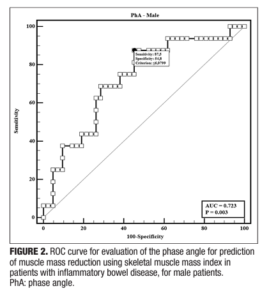HIGHLIGHTS
- This study aims to assess whether the phase angle is a parameter for predicting reduced muscle mass in patients with inflammatory bowel disease.
- There was a correlation of the phase angle with skeletal muscle mass and the associations remained in disease activity.
- The ROC curve analysis indicated that the cut-off point of the PhA ≤5.042° for women and PhA ≤6,079° for men can be used to predict muscle mass reduction.
- The phase angle can be considered a predictor of muscle mass reduction in inflammatory bowel disease.
ABSTRACT – Background –
Malnutrition/sarcopenia is frequent in patients with inflammatory bowel diseases (IBD), and results in muscle catabolism, impacting treatment response, postoperative complications, and quality of life. Objective – This study aims to assess whether the phase angle (PhA) is a parameter for predicting reduced muscle mass in patients with IBD. Methods – Adult patients with IBD were included in this cross-sectional study. For the estimation of muscle mass and the calculation of the PhA, we used bioelectrical impedance analysis (BIA). Crohn’s disease (CD) and ulcerative colitis (UC) activity scores were defined using the HarveyBradshaw index and partial Mayo score, respectively. The area under the ROC curve was calculated to identify the PhA cut-off point for reduced muscle mass. Results – The sample consisted of 145 patients, with 39 (26.9%) with IBD in the active phase. There was a correlation of the PhA with skeletal muscle mass (SMM) (rs 0.35, P<0.001) and with the skeletal muscle mass index (SMI) (rs 0.427, P<0.001), and the associations remained in the most active form (moderate or severe) of IBD. The ROC curve analysis indicated that the cut-offs points of the PhA ≤5.042 for female and PhA ≤6.079 for male can be used to predict muscle mass reduction. Conclusion – The PhA can be considered a predictor of muscle mass reduction in IBD patients, and we can use it for screening and monitoring the evolution of malnutrition.
AUTORES
Angela Martinha BONGIOLO, Marcos José MACHADO, Bruno Ayala LAZAROTTO, Maria Luiza Cimardi RUPP, Felipe DAL-PIZZOL and Maria Marlene de Souza PIRES.


